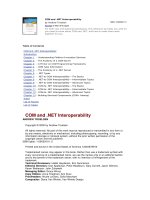Tài liệu IPTV and Internet Video doc
Bạn đang xem bản rút gọn của tài liệu. Xem và tải ngay bản đầy đủ của tài liệu tại đây (2.8 MB, 263 trang )
IPTV and Internet Video
Prelims-K80954.qxd 2/16/07 11:38 AM Page i
This page intentionally left blank
IPTV and Internet
Video: New Markets
in Television
Broadcasting
AMSTERDAM
•
BOSTON
•
HEIDELBERG
•
LONDON
NEW YORK
•
OXFORD
•
PARIS
•
SAN DIEGO
SAN FRANCISCO
•
SINGAPORE
•
SYDNEY
•
TOKYO
Focal Press Is an Imprint of Elsevier
Wes Simpson & Howard Greenfield
Prelims-K80954.qxd 2/16/07 11:38 AM Page iii
Senior Acquisitions Editor: Angelina Ward
Publishing Services Manager: George Morrison
Senior Project Manager: Brandy Lilly
Assistant Editor: Doug Shults
Marketing Manager: Christine Degon Veroulis
Cover Design: Eric Decicco
Focal Press is an imprint of Elsevier
30 Corporate Drive, Suite 400, Burlington, MA 01803, USA
Linacre House, Jordan Hill, Oxford OX2 8DP, UK
Copyright © 2007, Elsevier Inc. All rights reserved.
No part of this publication may be reproduced, stored in a retrieval system, or transmitted
in any form or by any means, electronic, mechanical, photocopying, recording, or
otherwise, without the prior written permission of the publisher.
Permissions may be sought directly from Elsevier’s Science & Technology Rights
Department in Oxford, UK: phone: (+44) 1865 843830, fax: (+44) 1865 853333,
E-mail: You may also complete your request on-line
via the Elsevier homepage (), by selecting “Support & Contact”
then “Copyright and Permission” and then “Obtaining Permissions.”
Recognizing the importance of preserving what has been written, Elsevier prints its
books on acid-free paper whenever possible.
Library of Congress Cataloging-in-Publication Data
Application submitted
British Library Cataloguing-in-Publication Data
A catalogue record for this book is available from the British Library.
ISBN 13: 978-0-240-80954-0
ISBN 10: 0-240-80954-8
For information on all Focal Press publications
visit our website at www.books.elsevier.com
07 08 09 10 11 10 9 8 7 6 5 4 3 2 1
Typeset by Charon Tec Ltd (A Macmillan Company)
www.charontec.com
Printed in the United States of America
ϱ
Prelims-K80954.qxd 2/16/07 11:38 AM Page iv
Contents
Dedication
ix
Acknowledgments
xi
About the Authors
xiii
Introduction
xv
Who Should Read This Book xvii
Features of This Book xviii
Summary xxi
Chapter 1
What is IP, and Why Use it for Video? 1
The Internet Protocol 3
The Market for IP Video 3
Arguments in Favor of IP Video 5
Arguments Against IP Video 9
Reality Check 12
Summary 15
Chapter 2
IPTV versus Internet Video 17
Characteristics of IPTV 18
Internet Video 22
Which Is Best? 26
Reality Check 27
Summary 29
Chapter 3
Business Models 31
IPTV 32
Internet Video 39
Reality Check 43
Summary 46
v
Prelims-K80954.qxd 2/16/07 11:38 AM Page v
Chapter 4
Network Overviews 47
Constructing an IPTV Network 48
Constructing an Internet Video System 59
Reality Check 66
Alternative Architectures 66
Summary 69
Chapter 5
IP—The Internet Protocol 71
A Simple Analogy 72
What Is a Packet? 73
How IP Fits In 73
Types of IP Networks 75
IP Addresses 78
Key Parts of an IP Network 79
Transport Protocols 81
Multicasting 82
Reality Check 86
Summary 88
Chapter 6
Video Compression 89
Why Compress? 90
Groups of Pictures and Why They Matter 92
MPEG 95
Microsoft Windows Media and VC-1 99
Other Compression Technologies 100
Digital Turnaround 102
Reality Check 103
Summary 104
Chapter 7
Maintaining Video Quality and Security 107
Factors that Affect Video Quality 108
Conditional Access 113
Digital Rights Management 117
Reality Check 117
Summary 119
vi
CONTENTS
Prelims-K80954.qxd 2/16/07 11:38 AM Page vi
Chapter 8
Sizing Up Servers 121
Video Servers 122
Video on Demand Servers 124
Advertising Servers 128
Live Streaming Servers 129
Encryption and Rights Management 130
Reality Check 130
Summary 133
Chapter 9
The Importance of Bandwidth 135
DSL Technologies 137
DSLAM 142
Home Gateway 142
Multiple Televisions 144
How to Calculate Bandwidth 145
Channel Changing 147
Bandwidth for a Triple-Play, HD Future 149
Reality Check 150
Summary 151
Chapter 10
Set Top Boxes 153
Basic Functions 154
Middleware 162
STB Selection Issues 165
Reality Check 165
Summary 166
Chapter 11
Internet Video Technologies 167
Types of Internet Streaming 171
Commercial Players 177
Content Creation Workflows 184
Reality Check 189
Summary 192
CONTENTS
vii
Prelims-K80954.qxd 2/16/07 11:38 AM Page vii
viii
CONTENTS
Chapter 12
The Future of IP Video 193
The IPTV Story So Far 193
Great Expectations 198
Portable Media: IPTV to Mobile Devices 201
Final Reflections 205
Summary 212
Glossary
213
Index
231
Prelims-K80954.qxd 2/16/07 11:38 AM Page viii
Dedication
Thanks to my loving wife, Laurie, and our fantastic children, Taylor and Cameron,
for giving me your support and gentle encouragement to embark on this fascinating
journey.
—Wes Simpson
Dedicated to my parents, Sam and Rose Greenfield, for lifting me on their shoulders
and keeping me in their great hearts.
—Howard Greenfield
ix
Prelims-K80954.qxd 2/16/07 11:38 AM Page ix
This page intentionally left blank
Acknowledgments
The authors would like to acknowledge the many industry experts and thought lead-
ers whose open, generous dialogues—and vision—have provided insights that con-
tribute so significantly to our work. This book benefits from their ideas and from
the influence of their efforts upon tomorrow’s technology, business, and culture.
We also salute a great many other kind individuals close to our work and dreams
for their help and support in pulling it all together to accomplish this awesome task:
Angelina Ward, Beth Millett, Joanne Tracy, Mark Weiss, Olaf Nielsen, Keith Galitz,
Gene de Vore, Justin Radke, Pierre Costa, John Trimper, Paul Atwell, Graeme Packman,
Cesar Bachelet, Jon Haass, Dan Gillmor, John Markoff, Françoise Groben, Barbara
Bouchet, Ephraim Schwartz, Susan Daffron, Jean Anderson, Bill Veltrop, Steve
Schneider and Clare Henjum.
xi
Prelims-K80954.qxd 2/16/07 11:38 AM Page xi
This page intentionally left blank
About the Authors
Wes Simpson is president and founder of Telecom Product Consulting, an indepen-
dent consulting firm that focuses on helping companies develop and market video
and telecommunications products. He is a frequent speaker and analyst for the video
transport marketplace; in the past three years alone he has spoken at IBC, NAB,
BroadcastAsia, SMPTE, VidTrans and a number of other conferences. Wes is author
of the well-received book “Video Over IP, A Practical User’s Guide to Technologies and
Applications” published by Focal Press in 2006.
Wes has more than 25 years experience in the design, development and market-
ing of products for telecommunication applications. Before founding Telecom Product
Consulting, he was COO of VBrick Systems, Inc., a manufacturer of MPEG video
equipment. Earlier, at ADC Telecommunications, Wes was the director of product
management for the DV6000, a market leading video transport system. He previously
held a variety of marketing and engineering positions in the telecommunications
industry. Wes was a founding member of the Video Services Forum, and was a mem-
ber of its Board of Directors from 1997 to 2001. He holds a BSEE from Clarkson
University and an MBA from the University of Rochester.
Howard Greenfield is president of Go Associates, a global consulting firm that
helps companies bring technology to the marketplace. He is a digital media and busi-
ness development strategist as well as an accomplished columnist, widely published
around the world. Howard has held senior management and consulting positions
with Sun Microsystems, Informix Software, British Telecom and Apple Computer. He
was the creator and leader of Sun’s first Media Lab and completed graduate studies
at Stanford University.
For the last two decades, Howard has been a successful technology developer,
manager, educator and writer. In addition to front-line collaborative development
ventures with Xerox PARC, Ericsson and the American Film Institute, he has held
leadership roles involving early stage start-up companies and established corpora-
tions, three of which were subsequently acquired by Ariba, IBM and Microsoft.
xiii
Prelims-K80954.qxd 2/16/07 11:38 AM Page xiii
Howard has presented and moderated at conferences throughout Silicon Valley,
Europe, and Asia. He has served on government and cultural advisory boards that
include the State of California, UK Trade & Invest, CNET and others. He also
worked in the Apple Classroom of Tomorrow research and development, and is
currently a board member of BlueVoice.org, an Internet media non-profit dedicated
to protecting ocean life and habitats.
The authors welcome any comments, questions, or insights from readers. Please
feel free to send e-mail to Wes at and Howard at
xiv
ABOUT THE AUTHORS
Prelims-K80954.qxd 2/16/07 11:38 AM Page xiv
Introduction
The world is changing very fast. Big will not beat small anymore. It will be the fast
beating the slow.
—Rupert Murdoch
The traditional business model for broadcasters, which has worked reasonably well
for the past few decades, is starting to break down. Increasingly, consumers are
demanding (and starting to receive) their video content in ways that were impracti-
cal even a few years ago. Consider the following:
●
Television Has Moved to the Web. Viewers around the world tuned in to watch
the 2006 FIFA World Cup in record numbers using their PCs and other Internet
connected devices. InFront Sports reported more than 125 million downloads
1
from the fifaworldcup.com Web site of two-minute video clips with game sum-
maries. While this number pales in comparison with the estimated 32 billion
viewers of live broadcast coverage, the number of clip downloads increased by
a huge factor between 2002 and 2006.
●
It’s All Personal: PVR Timeshifting and Ad-Zapping. The use of personal video
recorders in the U.S. has skyrocketed over the past few years, with a variety of
stand-alone solutions as well as those integrated into set top boxes from satel-
lite and cable television providers. Worldwide sales in 2005 totaled 19 million
units, and 11 percent of U.S. households have units.
2
Broadcast advertisers
have grown increasingly upset by the practice of commercial skipping and the
1. fifaworldcup.yahoo.com/06/en/060713/1/8s8z.html
2. In-Stat, June 5, 2006,www.instat.com/press.asp?SkuϭIN0603110ME&IDϭ1680
xv
Prelims-K80954.qxd 2/16/07 11:38 AM Page xv
loss of their ability to control the timing when viewers watch ads for specific
events, such as movie openings or store sales.
●
Media Has Gone Mobile. In Asia, mobile phones are just beginning to be used
to deliver both broadcast and on-demand video services. Reports show that by
2010, there will be 68 million mobile TV users in Asia,
3
or 55 percent of the
worldwide total of 120 million. Also, new standards for mobile file and stream
delivery are often based on IP technology, indicating an increase in market
penetration in coming years.
●
Everyone Wants to Be a Producer. Meanwhile, a wide range of user generated
video content continues to drive viewers to sites like youtube.com which gen-
erated more than 100 million downloads per day in 2006. Clearly, at least for
certain types of content, viewers are perfectly happy to watch video on normal
PC displays.
●
Podcasting Is Official. Over 500,000 listeners downloaded podcasts of Ricky
Gervais’ free weekly show in early 2006, and the term “podcasting” has officially
become part of the language.
●
You Are Now Free to Placeshift. Devices from Sling Media, Apple and many oth-
ers are now allowing consumers to move content among several different view-
ing devices, such as PCs, home television sets and portable media players.
What had been only whisperings about the promise of new digital media networks
for the last 25 years is now becoming an audible roar on the horizon, and a commercial
revolution is building. How will traditional broadcasters compete with the surge of
disruptive technology ahead? One way is by understanding and harnessing some of
the key technologies that support these competitive video outlets. Both IPTV
and Internet Video depend on IP technology, something not lost on the broadcast-
ing industry.
Television broadcasters have long been intensive IP technology users. A walk
around any modern video production facility will reveal all types of devices that
use IP technology, from digital editing stations to file servers to playout control sys-
tems. It is also highly unusual nowadays to find a broadcast executive who doesn’t
use some type of IP enabled device, such as a laptop computer, portable e-mail
device or voice over IP telephone.
xvi
INTRODUCTION
3. Business Week, June 20, 2006,
www.businessweek.com/globalbiz/content/jun2006/gb20060620_115324.htm?chanϭtc
Prelims-K80954.qxd 2/16/07 11:38 AM Page xvi
However, until recently, it has not been feasible to deliver broadcast-quality
video over IP networks to consumers. Today, with the growth of high speed networks
to consumers and the adoption of IP technology by carriers around the world, video
delivery over IP networks is not only feasible, it is becoming the only way to reach
some categories of viewers. The key for both established and aspiring video content
distributors will be to understand how IP technology will affect the ways viewers
watch and pay for video content.
In this book, we explore both the technologies of video delivery and the busi-
ness aspects, as IP increasingly makes a bold mark across production, delivery and
business practices. IP technology creates a wide array of new ways to deliver con-
tent to consumers, particularly when compared to traditional linear broadcasting
supported by advertising. From a business perspective, IP video opens up many
avenues for generating revenue, including customer payments in many forms and
opportunities for sponsorships and advertising. The ease of implementing new
technologies on an IP platform means that different business models can be sup-
ported. It’s a combined creative challenge and window of opportunity.
Who Should Read This Book
This book is focused on providing readers a good, direct understanding of the tech-
nologies and business issues surrounding IPTV and Internet Video. Care is taken to
present major concepts clearly while staying above the specific details of individ-
ual implementations. Case studies are used to provide real-world examples of this
technology being used to deliver actual services to paying customers.
Executives, managers and technologists will benefit from this information.
Executives will find a guide to many different technology and business options that
can be used to attain strategic goals for many different kinds of organizations, ranging
from large established media and telecommunications providers to small startups.
Managers will find a variety of technologies and business models that can be used
to achieve their organizations’ strategic video delivery business goals. Technologists
will find overviews of a number of different tools and techniques that can be used to
construct video delivery systems, allowing them to quickly identify areas for further
research and paths to implementation.
Many different industry segments are about to be significantly affected by the
coming wave of IPTV and Internet Video delivery systems.
●
Existing broadcasters will be introduced to a variety of techniques that can be
used to deliver content and new ways to enhance viewer experiences.
WHO SHOULD READ THIS BOOK
xvii
Prelims-K80954.qxd 2/16/07 11:38 AM Page xvii
xviii
FEATURES OF THIS BOOK
●
Telecommunications network operators will discover a range of services and
delivery models that will enable their companies to benefit from existing plant
and infrastructure investments, as well as providing a guide to new possibilities
for network migration.
●
Media providers and content owners will see a range of choices that can be used
to deliver content to viewers in both local markets and around the globe, and will
see different business models for maximizing the value of their assets.
●
IT architects and software developers will get a high-level view of ways that
applications, middleware and server systems are being integrated into media
delivery, creating new, hybrid network operations.
●
Investors will gain a deeper understanding of the technologies and business prac-
tices that impact this wildly diverse marketplace and generate new investment
models. The increased ability to identify specific sectors that warrant their sup-
port will drive clearer investment decisions.
Features of This Book
This book has been designed to make it easy for readers to find a wide variety of
information quickly and efficiently. The following three features complement the
main focus of each chapter to provide even more insight for decision makers.
The Corner Office View
Placed near the beginning of each chapter is a brief “Corner Office View” section. Each
of these sidebars offers direct quotations from influential industry executives pioneer-
ing the future who offer meaningful perspective on the industry and its new direction.
Reality Checks
Because this book is aimed at decision makers who need to understand both the
benefits and drawbacks of this new technology, we have added a section at the end
of each chapter to serve as a Reality Check. Sometimes, this section will be devoted
to application studies or market data that pertain to the subject of the chapter. Other
times, we will focus on issues or concerns that may serve to limit the widespread
deployment of a technology. Either way, we hope to highlight issues that will help
readers to get a better understanding of the wild and wonderful world of IP video.
Prelims-K80954.qxd 2/16/07 11:38 AM Page xviii
FEATURES OF THIS BOOK
xix
Glossary
Understanding the jargon used in this industry is essential to gaining a good appre-
ciation of the important issues facing executives. This book includes an extended
glossary, with more than 150 technical terms defined in crisp, clear language.
Organization of this Book
Each chapter is designed to address an important issue for broadcasters and service
providers. Readers are encouraged to choose whatever chapters interest them in
any order, with the caveat that some of the more fundamental topics are described
in the early chapters. In some cases, the latter chapters will refer to information pre-
sented in early chapters.
Chapter 1: What is IP, and Why Use it for Video?
This chapter analyzes the basic motivations for using IP networks to deliver video serv-
ices. We also take a look at the market trends driving the rapid growth in this market.
Chapter 2: IPTV vs. Internet Video
This chapter focuses on the differences between “IPTV” and “Internet Video,” terms
that are often used in very similar contexts by experts. IPTV offers multiple channels
of programming distributed to viewers who use a set top box and a television. Internet
Video consists of thousands or millions of individual video files viewed using a PC.
Chapter 3: Business Models
Many different business models are being tried for both IPTV and Internet Video.
We cover equipment costs, programming costs and viewer payment methods. We
conclude with an in-depth look at a real IPTV system that is meeting its financial
goals ahead of plan.
Chapter 4: Network Overviews
This chapter covers the basic architecture of both IPTV and Internet Video systems.
All of the key elements of both types of systems are described, including hardware
and software functions.
Chapter 5: IP—The Internet Protocol
IP is essential for IPTV and Internet Video. We provide a good introduction to IP
and some popular types of devices that support it. Multicasting, a key concept for
IPTV, is also explained.
Prelims-K80954.qxd 2/16/07 11:38 AM Page xix
Chapter 6: Video Compression
Video compression is a requirement for essentially all IPTV and Internet Video sys-
tems. We begin with a discussion of the basics and then describe the most popular
compression systems—the MPEG family, Microsoft Windows Media, and others.
Chapter 7: Maintaining Video Quality and Security
This chapter focuses on video quality and security. Video and network impair-
ments are described, along with what system designers have done to minimize or
compensate for those errors. Several techniques for both conditional access and
digital rights management are described.
Chapter 8: Video Servers
Servers are often used for IPTV and Internet Video systems. Several technologies
are described, including a focus on servers used for VOD, advertising and live
streaming, which are all key for IPTV and Internet Video systems.
Chapter 9: The Importance of Bandwidth
Many different services compete for a limited amount of IP bandwidth. We examine
an emerging ecosystem of DSL technology and home networks and give an example
of network bandwidth calculation.
Chapter 10: Set Top Boxes
The set top box (STB) is a crucial component of any IPTV network. It must receive
video packets, decompress them and display images in real time. The STB and
middleware systems must also handle all of the user interaction for an IPTV system
Chapter 11: Internet Video Technologies
A variety of different technologies can be used for Internet Video services, includ-
ing true streaming, download, and progressive download and play. We look at each
of these technologies and the associated protocols and media players.
Chapter 12: The Future of IP Video
This chapter looks at a range of possible futures for both IPTV and Internet Video.
Business drivers, advanced technology and mobile media devices are all discussed.
We wrap up with a look through the eyes of business leaders, soothsayers and tech-
nical wizards as they try to discern the future from a variety of perspectives.
xx
FEATURES OF THIS BOOK
Prelims-K80954.qxd 2/16/07 11:38 AM Page xx
SUMMARY
xxi
Summary
Throughout this book, you will find discussions about the future and about some of
the forces re-shaping video as a medium. Including this perspective has been inten-
tional. IP has nearly unlimited creative potential for re-inventing the way common
tasks are accomplished and how entire global architectures are implemented.
Without a constantly improving Internet functionality, this book could never have
been written. As the Web becomes more powerful and IP applications more elegant,
perhaps the next edition of this book won’t even be printed on paper. Perhaps it will
be released as part of a new online channel, with interactive segments and multime-
dia showcases featuring the systems, people and processes.
It’s clear the future is going to be different from the broadcast and communica-
tions environment of today. We hope the reader will enjoy the insights and benefit
from the expertise we’ve strived to provide. Moreover, we trust this book will
provide a key to understanding the vast range of opportunities that will involve us
all as technology and business developers, and as an audience in a new world of
media.
Prelims-K80954.qxd 2/16/07 11:38 AM Page xxi
This page intentionally left blank
1
What is IP, and Why
Use it for Video?
Nothing is really real unless it happens on television.
—Daniel J. Boorstin (American social historian and educator)
1
Before we try to answer this question, it’s appropriate to consider what may
be obvious – that video transport over Internet Protocol (IP) networks is not only
here today, but is poised to become a dominant form of video service delivery
for the next 20 years. As it unfolds, new media communications services that
only the imagination can anticipate will arise along with it. We are at the dawn
of an era that some hail as possibly the most fascinating phase in broadcasting
history.
We will discuss the reasons more in this chapter, and the spread of IP will form
a subtext throughout the rest of this book. However, there is little doubt that a
large and vigorous market is developing though a confluence of improved compres-
sion, faster data links, more sophisticated software and evolving viewer habits.
So, let’s explore these trends, see how they impact network, technology, and busi-
ness decisions today and, in the final chapter, see where these trends may lead us
in the decades ahead.
Digital video is a precisely timed, continuous stream of constant bit rate informa-
tion, which commonly works on networks where each signal is carried over a network
that is purpose-built for video. In contrast, IP networks carry many different kinds of
data from a huge variety of sources on a common channel, including e-mail, Web pages,
instant messaging, voice over IP (VoIP) and many other types of data. With all of this
data flowing together, the Internet is, at best, a loosely timed collection of information
that is broken up into discrete packets. Clearly, IP and video don’t make an ideal marri-
age of technologies.
Ch01-K80954.qxd 2/16/07 4:23 PM Page 1
In spite of this fundamental incompatibility, the market for IPTV and Internet
Video is exploding. Why? Well, the answer to that question boils down to five basic
arguments:
●
Because broadband IP networks reach so many households in developed coun-
tries, video service providers can use these networks to launch video services
without having to build their own networks.
●
IP can simplify the task of launching new video services, such as interactive pro-
gramming, video on demand (VOD) and targeted, viewer-specific advertising.
●
The cost of IP networking continues to decline due to the massive
volume of equipment produced each year and the existence of worldwide
standards.
●
IP networks can be found in every country in the world, and the number
of users with high-speed Internet connections continues to grow at a rapid
pace.
●
IP is a perfect technology for many other applications, including data transac-
tions (such as e-mail or banking), local area networking, file sharing, Web
surfing and many others.
In this chapter, we will begin with a brief summary of the market trends for IPTV
and Internet Video. We will then discuss in greater depth the five forces mentioned
above that are driving the migration of video into IP, followed by a look at some
issues that need to be addressed by any system trying to send video over an
IP network. We’ll conclude with a case study of a successful IPTV network
installation.
2
CHAPTER 1 What is IP, and Why Use it for Video?
The Corner Office View
“IPTV is a huge growth initiative. It’s huge for us, it’s huge for our partners. Count the
number of TVs, and you don’t have to get a lot of money per TV per year to start feeling
kind of excited about the size of the opportunity.”
— Steve Ballmer, CEO, Microsoft, speaking to analysts in July 2006
1
1. IPTV International, Volume 2, Issue 2
Ch01-K80954.qxd 2/16/07 4:23 PM Page 2









